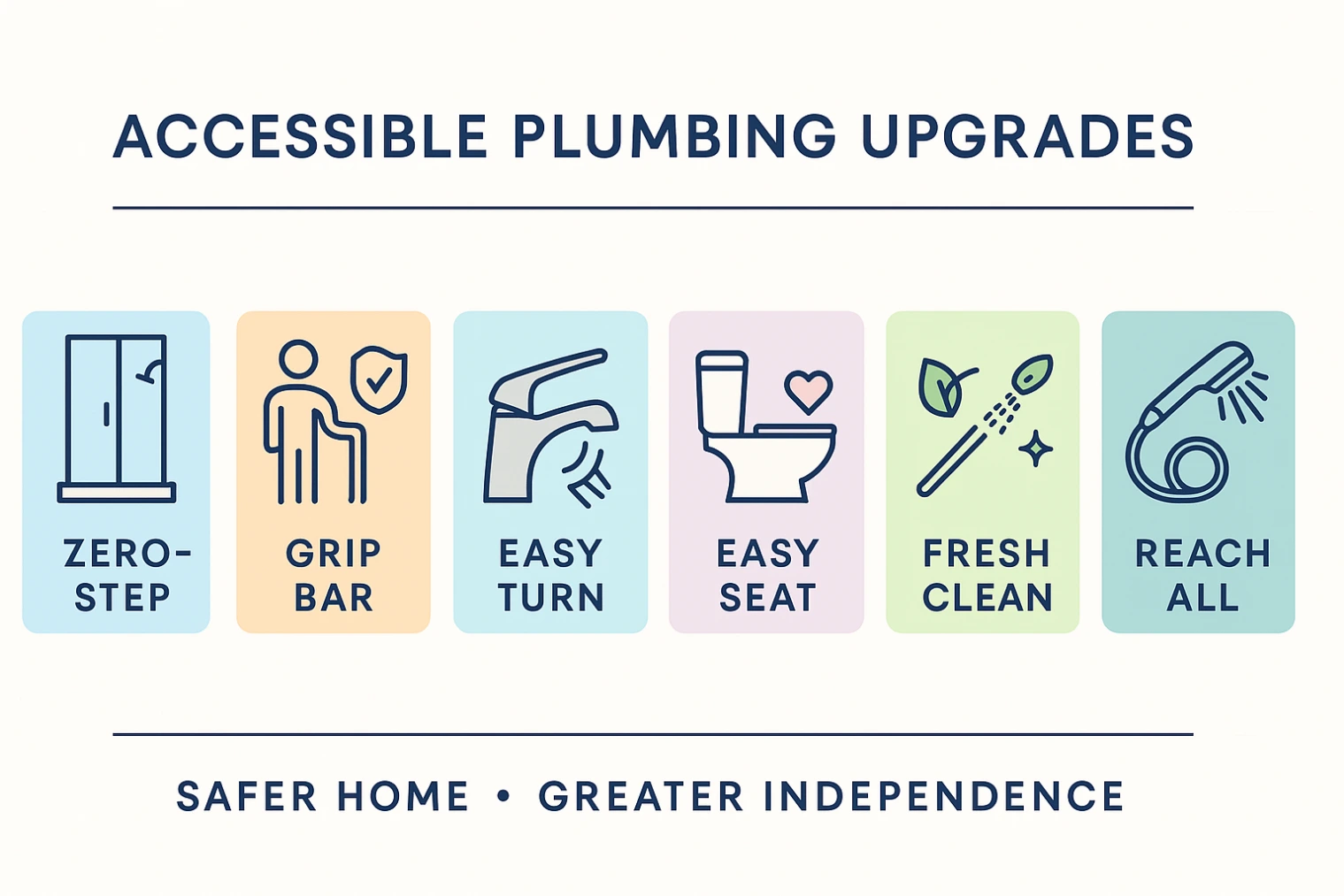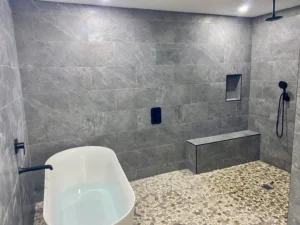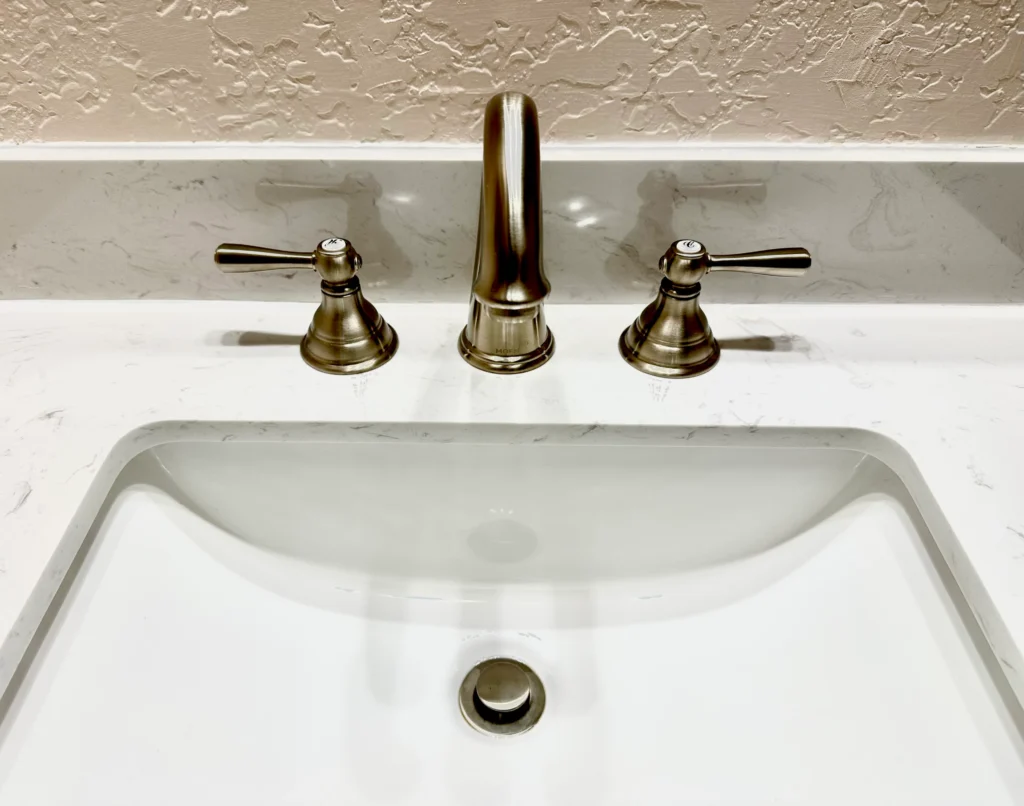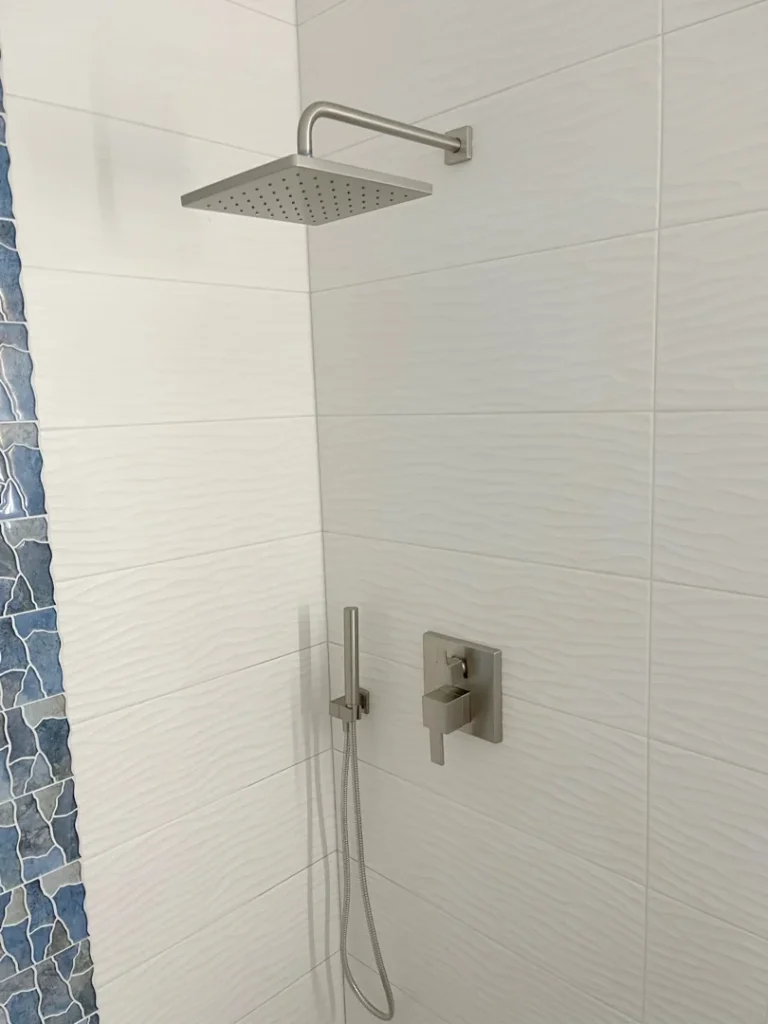Takeaways
- Accessible plumbing upgrades protect health, lower utility costs, and boost property value, making them a practical, future-proof investment for aging in place.
- Why Accessible Plumbing Matters in Retirement Communities and Neighborhoods
- Barrier-free features—curbless showers, slip-resistant floors, and well-placed grab bars—dramatically cut fall risk and keep daily routines safe.
- Smart fixtures such as lever-handle faucets, comfort-height toilets, bidets, and handheld showerheads increase comfort, hygiene, and ease of use for all ages.
Florida welcomes retirees every day, and many want to stay independent at home. Mobility often changes with age, so routine tasks like bathing and cooking can suddenly prove risky. A recent CDC report recorded over 234,000 annual bathroom injuries, most due to falls. Accessible plumbing upgrades protect health while preserving dignity and household budgets. We design these solutions so residents move confidently, not cautiously. Smart fixtures also save water and lower bills, stretching fixed incomes without compromising style.

Designing Barrier-Free Bathrooms That Don’t Sacrifice Style

Curbless Showers and Wet Rooms for Maximum Access
We create zero-entry showers that eliminate dangerous steps and tripping edges. Slip-resistant tiles paired with linear drains move water efficiently, so puddles never form. Shower benches provide a comfortable place to bathe without needing to stand and balance for prolonged periods. Frameless glass keeps the space bright and modern while allowing walkers or wheelchairs to roll in smoothly. Because the entire floor sits level, cleaning becomes quicker and safer. Homeowners therefore enjoy a spa-like appearance that quietly delivers life-saving functionality.

Grab Bars: Small Installations, Big Safety Gains
Strategically placed grab bars turn slippery zones into stable platforms. A controlled study showed grab bars boost balance recovery by about seventy-five percent during bathtub exits. We anchor bars into studs, ensuring they hold body weight during transfers or sudden slips. Sleek finishes—brushed nickel, matte black, or chrome—blend with contemporary décor rather than announcing “hospital.” Grab bars beside the toilet assist lifting, while bars in the shower aid balance when turning. Consequently, clients feel supported, confident, and proud of their stylish, accessible bath.

Smart Faucet Solutions for Limited Hand Mobility
Lever Handles vs. Knobs: A Clear Winner for Dexterity
Arthritis often stiffens fingers, so round knobs grow painful to twist, whereas high-quality plumbing fixtures with lever handles resolve matters. Lever handles require a gentle motion rather than a firm grip, easing daily routines. Temperature control stays precise because each lever moves smoothly with minimal effort, preventing scalds. Single-lever mixers that combine hot and cold lines avoid awkward two-hand coordination. The universal design benefits family members of all generations, including children and adults alike. Lever faucets therefore enhance comfort while modernizing the sink area.
Touch and Motion-Activated Faucets: Hands-Free Hygiene
Touch or motion sensors offer germ-free control for users with limited dexterity or messy hands. A quick wrist tap or wave starts the water, leaving grips clean and stress-free. These faucets include adjustable shut-off timers, avoiding accidental overflows and conserving water. Installation fits most existing supplies, so upgrades finish within hours. Because batteries last years, maintenance stays simple. Consequently, clients gain effortless hygiene and lower utility costs.
Kitchen Modifications That Make Meal Prep Easier
Pull-Down Spout Faucets: Convenience Without Strain
Pull-down sprayers bring water directly to heavy pots, reducing lifting hazards. Flexible hoses reach every corner, so rinsing produce feels effortless. Because the magnetic dock or weighted nozzle snaps back securely, the spout never droops or leaks. Spray settings alternate between aerated streams and powerful rinses, tackling delicate dishes and stubborn grime alike. As a result, cooking and cleanup remains joyful, not exhausting.

Toilet Upgrades That Support Safety and Dignity
Choosing a Comfort-Height Toilet
Comfort-height toilet seats sit 17 to 19 inches from floor level, matching an average chair. This elevation reduces knee bending and eases wheelchair transfers.
Elongated bowls improve stability, while soft-close lids prevent startling slams. An ADA standard confirms this height range, so compliance and resale value increase together. Therefore, users maintain independence while protecting aging joints from strain.
Bidet Attachments for Better Hygiene
Non-electric bidet attachments mount under existing seats in minutes, supplying gentle water cleansing. Adjustable nozzles and pressure dials let users tailor comfort without twisting bodies. Because hands stay cleaner, skin irritation decreases, and toilet paper use plummets. Some models include self-cleaning wands, reducing maintenance chores. Therefore, bathrooms become both hygienic and eco-friendly.

Customizing the Shower Experience
Adjustable & Handheld Showerheads: Full Control in Any Position
Handheld wands slide on vertical bars, letting users choose perfect height whether standing or seated. Lightweight hoses reach backs, legs, and feet without acrobatics.
Multiple spray patterns soothe aching muscles or rinse shampoo quickly. Because pause buttons cut flow while lathering, water waste shrinks. Thus, showers provide relaxing therapy rather than slippery stress.
Shower Benches & Transfer Seats
Built-in benches anchor securely to walls and support full body weight. Fold-down seats save space when not needed yet deploy instantly for fatigue relief. Waterproof teak or composite materials resist mold and stay warm to the touch. With integrated legs and bracing, transfer seats assist wheelchair users gliding across safely. As a result, bathing regains comfort, privacy, and confidence.
FAQ: Common Questions About Accessible Plumbing
What’s the average cost of converting a standard bathroom to an accessible layout?
Costs vary by fixture quality, tile choice, and structural changes, yet comprehensive projects typically range from $15,000 to $30,000. We perform a detailed assessment to prioritize high-impact plumbing upgrades first, controlling budgets wisely. Labor forms the largest expense, especially when moving drains. Because each home differs, we always provide transparent, itemized quotes before work starts. Unexpected pipe issues uncovered during leak detection may adjust the final price.
Are accessible plumbing upgrades eligible for tax credits or insurance coverage?
Some medical necessity modifications qualify for federal medical expense deductions or state incentives. We can provide documentation to occupational therapists supporting your claim. Certain long-term-care insurance plans also reimburse many home safety projects. Each provider sets its own rules, so clients should verify coverage early. Our team helps gather invoices and product details to streamline paperwork.
Can I install grab bars or bidets without remodeling the whole bathroom?
Yes, many grab bars, handheld shower sprayers, and bidets retrofit existing fixtures quickly with minimal disruption. We locate wall studs or install secure anchors to ensure weight support. Non-electric bidets tap into your current supply line, avoiding electrical work. These targeted upgrades offer immediate safety gains while you plan larger renovations. Because installation often takes only a few hours, project downtime remains pleasantly minimal.
How do I know if my bathroom meets ADA or aging-in-place standards?
We measure clearances, fixture heights, and reach ranges against ADA guidelines and universal design best practices. Turning radius requirements ensure wheelchairs navigate comfortably within the room. Slip-resistant surfaces and proper grab bar placement reduce fall risk during every transfer. After inspection, we provide a detailed report with recommended improvements. This proactive approach protects occupants and enhances property value substantially.
The cost and installation comparison below helps homeowners plan their accessible plumbing upgrades at a glance. Figures reflect typical Southwest Florida pricing and highlight ongoing maintenance considerations.
| Upgrade | Typical Installed Cost (USD) | Average Install Time | Maintenance Needs | Key Added Value |
|---|---|---|---|---|
| Curbless shower / wet room | $8,000 – $15,000 | 3 – 5 days | Annual grout / seal inspection | Zero-step safety, seamless design |
| Comfort-height toilet | $450 – $900 | 2 – 3 hours | Wax ring replacement every 5–7 yrs | Easier transfers, joint relief |
| Grab bars (pair) | $200 – $400 | ≈ 1 hour | Check mounting annually | Stable support, fall prevention |
| Lever or touchless faucet | $300 – $650 | 1 – 2 hours | Battery change every 2 yrs (touchless) | Easy control, hygiene boost |
| Bidet attachment (non-electric) | $100 – $250 | ≈ 30 minutes | Filter change yearly (some models) | Improved hygiene, reduced paper use |
| Handheld showerhead | $120 – $250 | ≈ 30 minutes | Hose gasket replacement every 3–4 yrs | Targeted cleaning, water efficiency |
| Pull-down kitchen faucet | $350 – $700 | ≈ 2 hours | Sprayer hose check every 5 yrs | Strain-free rinsing, versatility |
3 Practical Tips for Getting Started with Accessible Plumbing
Start with the Highest-Risk Zone
Falls most often occur in showers or around toilets because water creates slick surfaces. Identify the spot where you feel most unsteady, then prioritize that upgrade. Installing grab bars and slip-resistant flooring immediately cuts accident chances. Afterward, address secondary risks like faucet control or lighting. This phased strategy delivers quick safety wins without overwhelming budgets.
Test Before Committing
Temporary suction grab bars, adjustable stools, or demo faucets let you trial configurations. Real-world testing reveals ideal heights, angles, and control styles before drilling permanent holes. Feedback then guides final selections, ensuring satisfaction. Pilot testing saves money by preventing costly mistakes.
Think in Bundles
Combining related fixtures—comfort-height toilet, bidet, and grab bar—reduces labor duplication and shortens project timelines. Contractors work once rather than scheduling multiple visits, lowering costs. Coordinated finishes create cohesive aesthetics that elevate bathroom appeal. Clients also enjoy faster transitions back to normal routines. Bundled upgrades therefore maximize value and convenience.
Why Accessible Plumbing Is an Investment in Quality of Life
Accessible plumbing safeguards health, extends independence, and protects financial assets. By reducing fall risks, homeowners avoid hospital bills and rehabilitation downtime. Energy-efficient fixtures lower monthly utilities, freeing income for hobbies or travel. Modernized spaces also attract future buyers who appreciate thoughtful design. When families visit, inclusive bathrooms welcome everyone comfortably. Smart upgrades enrich everyday living and honor the desire to age gracefully at home.
- Plumbing Durability for SWFL Rental Properties: Choosing Fixtures and Systems That Withstand High-Occupancy Wear and Tear - November 25, 2025
- Flo Smart Leak Protection for Cape Coral & Fort Myers Seasonal Homes - November 18, 2025
- The Essential Post-Storm Plumbing Inspection Checklist: Protecting Your Fort Myers/Cape Coral Home from Hidden Hurricane Damage. - November 11, 2025